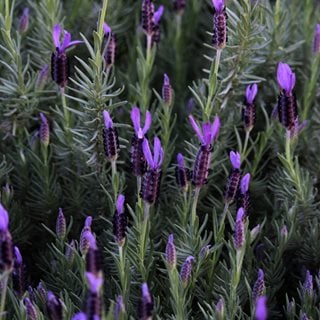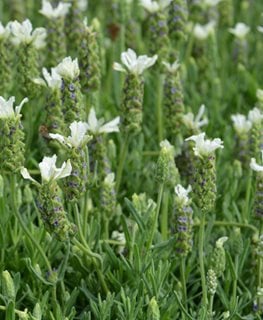Growing & Caring for Spanish Lavender
Unique bunny-eared blooms make Spanish lavender a real standout in both the garden and a vase.Prized for its flamboyant flowers and silvery, aromatic foliage, Spanish lavender (Lavandula stoechas) is the showiest of the garden lavenders, with tall petal-like bracts that rise above plump flower spikes like the ears of a rabbit. Compact, shrub-like, and highly ornamental, this versatile lavender is a beautiful addition to mixed perennial beds, herb gardens, borders, rock gardens, and containers. It also thrives in hot, dry conditions, making it ideal for warmer climates and waterwise landscapes.
On this page: Basics | Planting | Care | Varieties | Harvesting & Preserving
- BASICS
- HOW TO PLANT SPANISH LAVENDER
- SPANISH LAVENDER CARE
- SPANISH LAVENDER VARIETIES
- FREQUENTLY ASKED QUESTIONS
BASICS
Botanical name:
Lavandula stoechas
Common names:
Spanish lavender, butterfly lavender, rabbit’s ears, bract lavender, topped lavender. May sometimes be incorrectly referred to as French lavender, a name that should be reserved for Lavandula detata.
Plant type:
Woody perennial
Native area:
Mediterranean region and North Africa
Zones:
Typically 7-10, although some cultivars are hardy down to Zone 6
Exposure:
Full sun
Size:
10 to 24 inches tall, 1 to 3 feet wide
Bloom time:
Late spring through summer
Foliage:
Silver or gray-green, highly fragrant leaves are similar to rosemary in scent and appearance. Foliage remains evergreen in warmer climates.
Flowers:
Flowers are typically shades of deep purple or pink, while the bracts may be lavender, light pink, or white, depending on the cultivar.
Special attributes:
- Heat and drought tolerant
- Attracts bees, butterflies, and other beneficial insects
- Rabbit and deer resistant
- More tolerant of humid conditions than other lavenders
Toxicity:
All types of lavender contains a small amount of linalool, a compound that may be toxic to dogs and cats, according to the ASPCA, especially if ingested in large quantities.
PLANTING SPANISH LAVENDER
When to plant:
In the spring after the soil has warmed up and the threat of frost has passed. May also be planted in the fall as long as you give plants enough time for their roots to establish before winter.
Where to plant:
In a site that receives full sun (at least 6 hours daily). Plants will bloom poorly if not given ample sunlight. An area that receives good air circulation is also important, especially if growing plants in a humid climate.
How to plant:
It is generally easier to grow Spanish lavender from nursery starts, spacing plants far enough apart (depending on their width at maturity) to ensure good air circulation.
Soil requirements:
Thrives in sandy, silty, or rocky soils that provide excellent drainage. Will also perform well in poor soil, but avoid planting in heavy clay or in low spots prone to standing water. Because good drainage is essential, consider growing your plants in mounds, raised beds, or on slopes.
Growing from seed:
If want to try your hand at growing Spanish lavender from seed, be forewarned that the seeds are small and tend to have a slow and erratic germination rate. To get the best results, start the seeds indoors in early spring, covering them very lightly with a sterile seed starting mix and keeping them moist but not soggy until the seedlings emerge. When kept at a temperature of about 65° F, the seeds will germinate in 2 to 3 weeks.
Growing in containers:
If your garden soil is heavy and dense, consider growing Spanish lavender in a container in a high-quality potting mix with good drainage. Also, be sure that the pot has multiple drainage holes, so your lavender won’t be sitting in standing water. Potted lavender is susceptible to root rot if it the soil remains too moist for an extended period. Learn more about how to grow lavender in pots.
SPANISH LAVENDER CARE
Watering:
Although Spanish lavender is drought tolerant, you should water new plants regularly until the roots become established, keeping the soil evenly moist but not soggy. After the first year, let the soil become almost dry between waterings. To prevent root rot and fungal diseases, avoid overwatering and keep the leaves dry by watering at ground level or using drip irrigation.
Amendments and fertilizer:
Because Spanish lavender is native to areas with sandy or rocky soil, avoid using amendments that enrich the soil, such as compost or other organic matter. However, if you have dense clay soil, you should amend it with inert rice hulls and make sure to plant high and watch watering very carefully.
Fertilizing Spanish lavender is rarely necessary and may actually inhibit flowering. Plants will generally be healthier and longer-lived when grown in poor soil that is low in nutrients.
Pruning and deadheading:
Prune back Spanish lavender in spring after the first flush of blooms fade to stimulate new growth and encourage repeat flowering, lopping off about one-third of the top and sides. Because lavender will not grow back from old wood, drastically cutting an older plant down to its woody base can kill it, so be sure to make your pruning cuts just above new leaf growth. Give your lavender another light pruning in late summer to reshape the plant and promote denser, thicker growth. See more on pruning lavender.
Propagation:
From stem cuttings taken from new growth in spring, before flower buds form.
Pests and diseases:
Few pest or disease problems, but is susceptible to Phytophthora root and crown rot, particularly if the soil around the base of the plant remains wet for long periods of time.
SPANISH LAVENDER VARIETIES
FREQUENTLY ASKED QUESTIONS
Is Spanish lavender a perennial?
While Spanish lavender is often sold as a perennial, it’s actually an evergreen semi-woody shrub. That means you should never cut it back to the ground when pruning. When shaping is needed, remove no more than half of the plant’s size.
Is Spanish lavender edible?
Spanish lavender is edible but tends to be bitter and antiseptic in taste because of its high camphor content. English Lavender (Lavandula angustifolia) is a better choice for culinary use and has a slightly sweet, floral flavor.
Will Spanish lavender survive winter?
Spanish lavender will return year after year if grown in the appropriate climate. However, it is less hardy than its English cousin and may not survive harsh winters where temperatures drop below 10° F. If you live north of Zone 7, grow Spanish lavender as an annual or plant it in a pot that you can bring indoors or move to a protected location during the winter months.
Can Spanish lavender be grown indoors?
Spanish lavender will do quite well growing in a container indoors if given at least four hours of direct sunlight daily, ideally from a south-facing window. This is a great option if you live in a colder climate because it will ensure survival of your plant until you can move it outdoors in the spring, after all danger of frost has passed. Water your container-grown lavender when the top of the soil is dry to the touch, making sure the roots never sit in standing water.
When should I harvest Spanish lavender for fresh flowers?
Because of its showy bract-topped blooms, Spanish lavender makes a lovely cut flower. If you harvest the blooms when they are in early bud, they should last at least two weeks in a vase. If you want to dry the flowers, tie the cut stalks into bunches and hang them upside down in a dry, well-ventilated space out of direct sunlight.












